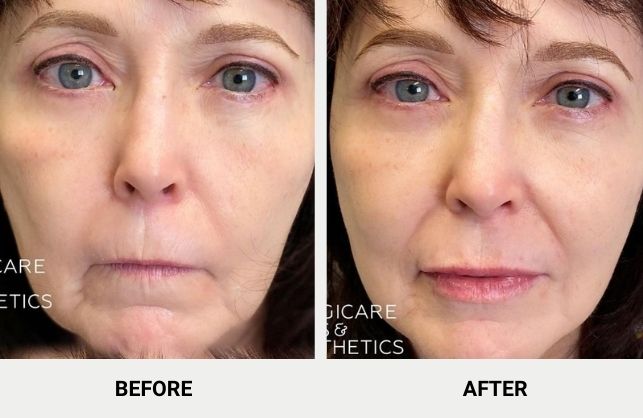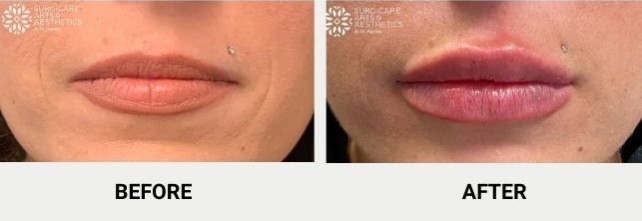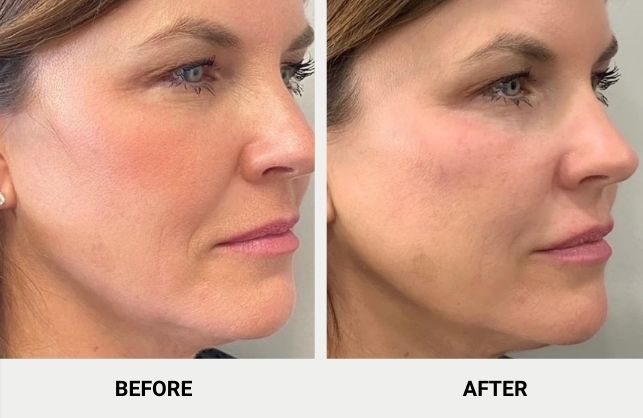With all the options available today, how do you know which dermal filler to choose? A consultation with your doctor is key to choosing the dermal filler that’s right for you. Your facial anatomy, the areas you desire to improve, and how long it will last will be among the determining factors in choosing the best filler for you.
As part of the natural aging process, our skin begins to thin out and collagen production slows down, causing the formation of fine lines, wrinkles, and volume loss. Today, we have the privilege of having products available to us to slow down the effects of the aging process through non-invasive and non-surgical dermal fillers. Restylane®, Juvederm®, and Sculptra® are all popular products that are available to help slow down the effects of aging.
What Types of Dermal Fillers Are Available?
There are natural dermal fillers and synthetic ones. Here is a quick comparison of some of the most popular derma fillers available on the market today: Restylane®, Juvederm®, and Sculptra. Both Restylane and Juvederm offer custom formulations created for specific areas of the face.
Restylane® Overview
Restylane was approved by the FDA in 2003, and the company has since added to their product line, with their newest addition approved in 2020. It is made with hyaluronic acid (HA), a substance that naturally exists in our skin. When hyaluronic acid is injected into specific areas, it restores the volume in that area.
Restylane is offered in different formulations, some including lidocaine, which helps ease injection discomfort. These formulations vary in particle size to address anything from fine lines and wrinkles to deep lines and also add increased volume.
The Restylane® product line includes:
- Restylane®-l,
- Restylane® Refyne,
- Restylane® Silk,
- Restylane® Kysse,
- Restylane® Lyft,
- Restylane® Defyne, and
- Dysport.
Restylane can last anywhere from 6-9 months. Side effects can include bruising, swelling at the injection site, and redness. Rare but more serious side effects can include infections, allergic reactions, keloids, superficial necrosis, etc.
Juvederm® Overview
Juvederm was approved by the FDA in 2006 for use as a cosmetic filler. The Juvederm family of products has continued to grow and gain approval from the FDA with Juvederm® Voluma XE being the newest on the scene with its 2019 FDA approval.
Juvederm is a combination of hyaluronic acid, water, and lidocaine. Hyaluronic acid (HA) helps hold in moisture and increase collagen production, and lidocaine helps ease discomfort during the injections.
There are five fillers in the Juvederm® family:
Each was created to work perfectly in different areas of the face. Juvederm tends to be a little more expensive, but the results last longer for most individuals.
Both Restylane and Juvederm are non-invasive, non-surgical procedures with no related downtime. The procedures take anywhere from 15 to 60 minutes, depending on the number of areas being treated. Because both Restylane and Juvederm are HA-based, it is possible to combine treatments or use them interchangeably. Both provide instant results and are also totally reversible.
You May Not Be a Good Candidate for Restylane or Juvederm
- have allergies to any ingredients in the injections;
- have a history of multiple severe allergies or allergic reactions such as anaphylaxis;
- tend to scar very easily or have pigmentation disorders;
- are taking blood thinners or any medication that thins the blood;
- have a history of bleeding disorders.



Sculptra® Overview
Sculptra is a bit different than Juvederm or Restylane in that it is made of a synthetic substance called poly-L-lactic acid. It is in the derma filler category but is not actually a filler. It is a substance that promotes collagen growth where it is injected. It has been on the medical scene since 1999 and was approved in 2004 by the FDA to treat lipoatrophy in HIV-positive patients. It was discovered that in and around the injection areas, new collagen was produced. In 2014, the FDA approved Sculptra for treating wrinkles and folds on the face.
Normally, two to three Sculptra treatments will be necessary over the course of a 2-3-month period. Unlike Juvederm or Restylane, where results are immediate, the results of Sculptra will appear gradually. The injections stimulate your body to produce more collagen, which naturally, over time, reduces the wrinkles and lines in your face. After about 8 weeks, your doctor will consult with you to discuss your progress and determine if more injections are needed. The results of Sculptra last 2–3 years.
Side effects may include injection site swelling, tenderness, redness, pain, bruising, bleeding, itching, and lumps. Other side effects that have been reported are the delayed onset of larger lumps, inflammation, and skin discoloration.
Restylane Filler vs. Juvederm For Lips
Full, luscious lips have become a sought-after beauty trend, with many people turning to dermal fillers like Juvéderm and Restylane to achieve that perfect pout. While both brands offer effective lip enhancement solutions, they have subtle differences in formulation, longevity, and suitability.
How do you choose? When comparing Restylane vs. Juvederm for lips, is one better than the other? Let’s take a closer look at these two options for lip augmentation so you can make an informed decision about which option may be right for you.
Composition
Since Juvéderm and Restylane are both hyaluronic acid-based dermal fillers, they are safe and well-tolerated. However, the difference lies in the science of how it is made, which is called “cross-linking technology. Juvéderm uses proprietary Hylacross technology, while Restylane employs NASHA technology. Juvéderm’s Hylacross technology results in a smoother gel consistency, making it slightly easier to inject. while Restylane gel is a bit firmer.
Longevity
The length of time your lip filler will last is an important consideration, and this may be important enough to sway you one way or another when choosing between Juvéderm and Restylane for lips.
Juvéderm typically lasts between 6 and 12 months, while Restylane tends to last slightly longer, ranging from 6 to 18 months. The exact duration may vary from person to person based on factors such as metabolism and the amount injected.
Results and Customization
Both Juvéderm and Restylane provide natural-looking results. However, some patients may prefer one over the other based on their desired outcome. Juvéderm is known for its soft, pliable consistency, making it an excellent choice for subtle enhancements and fine-tuning lip contours. Restylane, with its firmer texture, may be preferred by those seeking more dramatic volume.
Looking at Juvéderm vs. Restylane for lip enhancement, there is no definitive “better” option. The choice between the two largely depends on individual preferences, desired results, and budget. Ultimately, both Juvéderm and Restylane offer safe and effective solutions for achieving the plump, beautiful lips you desire.
If you are interested in dermal fillers to address the common signs of aging, schedule a consultation with Dr. Angelina Postoev.







